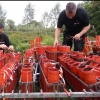Hi all
I've been away from the hobby for a little while for no other reason than my many other hobbies got in the way. Anyway I'm back at it again and once again my hand rammed rockets are the bane of my life.
I have some nicely made aluminium tooling and the best concentric, STRONG tubes money can buy but still I have issues with reliability. I won't go into too much detail about my multiple failures and multiple attempts to build a motor I can trust well enough to lift the equivalent header to about a 3 inch size shell or close to that. Strangely when I started out with inferior tubes and chemicals and experience I had greater reliability. All I will say is that over the many attempts I have tried all the obvious tweaks but I still get a significant number failing. Too many to trust putting a header on that is going to break quite hard.
The usual failure is the tube splitting but I've had the nozzle blow out and occasionally the bulkhead.
I've not given up and I will go back to basics with my ramming techniques, compositions, construction etc so I'm not seeking more advice there yet. One thing I wanted to try though but wanted opinions and advice on are nozzleless rockets but using tooling designed for a nozzled coreburner. From what I understand I could achieve this by using as hot a BP fuel mix as I can and ramming them just the same but without the clay nozzle.
Is that really all there is to it? I was going to give it a go and I wondered if this method might be more forgiving and reliable for someone who clearly needs to work on their nozzled core burners lol.
p.s. I would like to make a press but until I have more workshop space it's the one thing I am going to have to wait a bit longer for unfortunately.
















